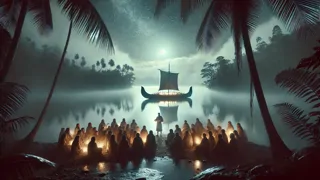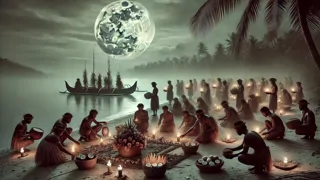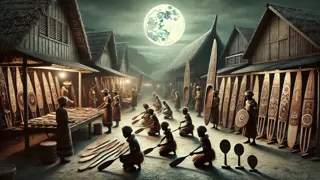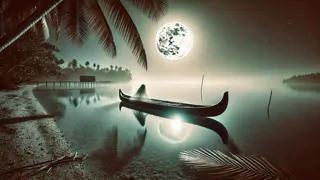Introduction
In the far reaches of the Solomon Islands, where tangled palm fronds cast perfumed shadows across tranquil lagoons, the Spirit Canoe emerges under every full moon. Locals speak in hushed tones of an eldritch vessel that glides over glassy waters, lit by a spectral glow and silent as a breath held between worlds. Fishermen at the water’s edge recall how the air grows cool, and the salt-scented breeze turns still as the phantom canoe drifts into view. No living oarsmen steer this ghostly craft, yet its path through the dark lagoon carries the souls of the departed toward unseen shorelines beyond mortal sight. While children are tucked safely indoors, and elders whisper prayers of protection, the young remain captivated by the stories that shape their understanding of life and death. This legend, older than memory, offers more than a ghost story—it weaves a bond between the living and their ancestors, inviting deep reverence for nature’s mystery and the courage to face the unknown. In whispered chants and carved totems, every detail of the story has been passed down through generations, ensuring no fragment of this sacred voyage vanishes with time. As our journey unfolds, you’ll learn the secret rites that greet the Spirit Canoe—and the price paid by those who break its solemn bonds.
Origins of the Spirit Canoe
The legend of the Spirit Canoe traces back through centuries of Solomon Islands oral tradition, carried on the hushed breath of village storytellers seated beneath starlit skies. According to the oldest accounts, a daring chieftain once lost his beloved daughter during a fierce storm that swallowed her paddling craft. Heartbroken and inconsolable, he called upon the ancestral spirits to guide her home. In answer, a luminous canoe rose from the depths of the lagoon, its curvature carved by unseen hands and its lanternlike glow piercing the turbulent night. Villagers claim that, from that night onward, whenever a life was claimed by sea or sickness, the canoe reappeared beneath the full moon to bear the soul gently toward the ancestors’ realm.

Elders recount that no human may step aboard when the Spirit Canoe drifts ashore; its purpose is sacred and solitary. Attempts by the unwary to approach too closely have led to unsettling visions: whispers in ancient tongues, spectral palms brushing against one’s shoulder, and the sensation of being watched by hollow eyes on the water. Despite these warnings, some have dared to leave offerings—woven mats, carved shells, bowls of kava—to honor the passage and secure their loved ones’ safe ferrying. Over generations, these rituals have woven a tapestry of respect and caution, uniting every community around the lagoon in shared devotion.
Archaeological digs along northern lagoons have unearthed fragments of old canoes buried beneath silt—some displaying carvings that echo the Spirit Canoe’s ornate prow. Anthropologists propose that these remnants may reflect a long-lost practice of carving funeral vessels to accompany the dead in mythic voyages. Yet no record names the Spirit Canoe; its creator remains veiled, as elusive as the vessel itself. Tales say that its planks are made from a tree that grows only in the spirit world, transported to our realm only when the veil between worlds grows thin.
In coastal villages, mothers hush their children at dusk, reminding them that the canoe will come to carry only those whose hearts remain pure. Young paddlers share trembling glances as they fish by moonlight, half-daring one another to glimpse its glow. The legend shapes daily life: prayers offered at dawn, small cairns of stones by the water’s edge, and woven garlands set afloat to honor departed kin. Through these simple acts, the living affirm their bond with those who have crossed over, ensuring that the specter of the Spirit Canoe remains a guide, not a harbinger of dread.
Rituals of Passage and Protection
Each full moon, the village drumbeat rises in a measured call that echoes across the lagoon, signaling the time when souls prepare to journey. Families gather at the water’s edge, carrying woven baskets of coconut oil, frankincense resin, and petals from the crimson hibiscus. These offerings are laid upon the sand in precise patterns known only to the clan’s matriarchs and priests, whose whispered chants invite the canoe’s gentle approach. The air fills with the scent of burning resin as flames dance over polished stones, marking the limits where the living may stand.

At the moment when the moon’s reflection fractures on the water’s ripples, the Spirit Canoe glides in without a ripple of its own, as though drawn by invisible currents. Villagers fall silent, heads bowed, as a hush of awe replaces the crackling fire. Though no living soul paddles that vessel, it comes to rest at the shore, lanterns flickering like fireflies. In that stillness, the elders name the deceased whose spirit will board. A single drumbeat calls back the departed, and a final wave of the hand—laden with the chosen offering—seals the passage.
Once the soul ascends on that lantern lit deck, the canoe retreats beneath the lagoon’s glassy surface, vanishing as inexplicably as it came. Those brave enough to peer into the depths say they glimpse a faint pathway of bioluminescent algae that lights the way toward the setting moon. No one follows the canoe beyond the knee-deep water; the spirits’ corridor remains sacred and unseen.
Protection rites extend beyond the full moon ceremony. When fierce storms threaten the islands, clans gather talismans carved in the shape of a canoe paddle, tying them to fishing nets and house doors. Mothers press blessed shells into their children’s hands before they venture to school or market, invoking the Spirit Canoe’s watchful guardianship. It remains a living belief—woven into daily prayers and acts of kindness—so that the boundary between life and death stays honored, and the canoe’s voyage continues unbroken.
Scholars note how these rituals reinforce communal bonds and respect for the sea’s power. By entwining grief with ceremony, the people of the Solomon Islands transform loss into an act of reverence. The Spirit Canoe becomes both the messenger of farewell and a promise that memories—and souls—will never vanish entirely.
Encounters and Enduring Legacy
Over the centuries, many visitors have sought the Spirit Canoe—anthropologists, sailors, and thrill seekers drawn by tales of a ghostly vessel. Some have claimed sightings from the deck of their own boats: a faint silver silhouette gliding past, then disappearing like mist at dawn. Others recount hearing faint drum rhythms in the night air, even miles from the lagoon, as if the canoe’s summoning echoes across the entire island chain.

In 1923, a British naval officer stationed near Guadalcanal recorded an entry describing “a luminous craft, uncrewed yet somehow alive, cutting through the lagoon like a phantom ship.” He noted how his crew refused to approach the shoreline until the brightness faded. Local elders later explained that any attempt to follow or photograph the Spirit Canoe without proper rites could invite misfortune—broken oars, disoriented vessels, and inexplicable seasickness.
Modern-day filmmakers and photographers have tried to capture evidence, but technical attempts falter: cameras overexpose or malfunction, lenses fog up, and batteries drain. The canoe seems to exist on a frequency that eludes modern detection. Yet each unsuccessful attempt only deepens the mystery, reminding the world that some stories resist capture in pixels and ink.
Today, the legend of the Spirit Canoe shapes festivals and educational programs across the islands. School children learn the old chants and paddle motions in cultural classes, connecting with ancestors through song and gesture. Artisans carve canoe decorations that blend ancestral symbolism with contemporary design, selling them in local markets as both souvenirs and sacred keepsakes.
Though the outside world changes rapidly, the Spirit Canoe endures as a symbol of continuity. It carries a reminder that life is a journey, that every ending gives way to new beginnings, and that respect for the unknown is the heart of true courage. In this way, the phantom vessel remains more than a ghost story—it is a living tradition, steering each generation toward deeper understanding of self, community, and the eternal tides of nature.
Conclusion
As dawn’s first light softens the lagoon’s mirror, the memory of the Spirit Canoe lingers in the ripples it left behind. Families return home to whisper prayers over hearth fires, keeping the promise that departed souls are safely guided onward. For each villager, the canoe is more than a spectral craft—it is the vessel of shared history, of stories passed from one generation to the next, and of respect woven into every wave and grain of sand. Though science may seek to explain every phenomenon, the Spirit Canoe remains a testament to the power of belief, reminding us that some mysteries are meant to dwell at the intersection of reality and wonder. In honoring its passage, the people of the Solomon Islands affirm their bond with the unseen realm and carry forward a legend that will endure as long as the moon rises above the palms.

















